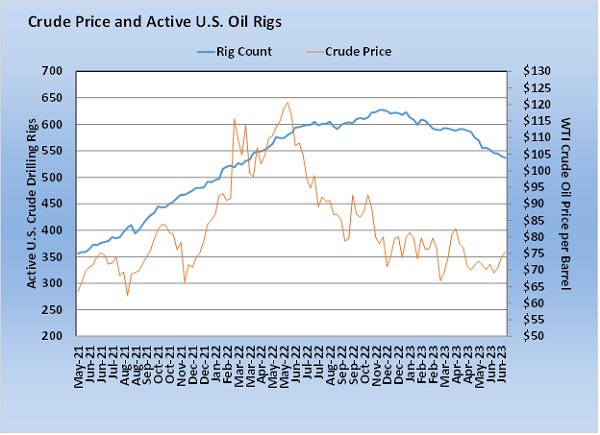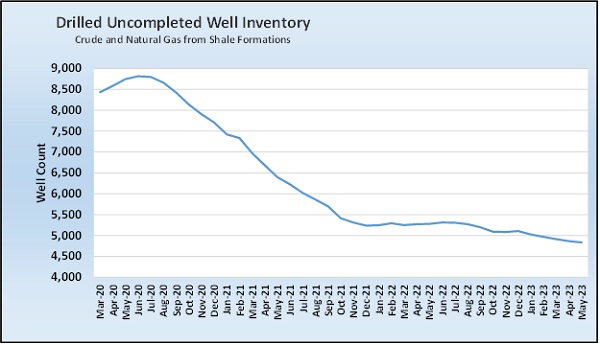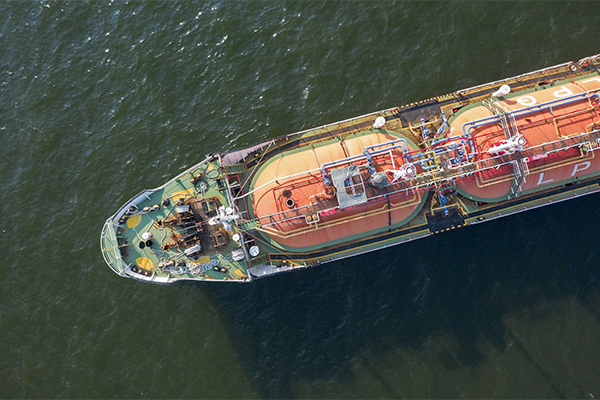|
|
|
THIS WEEK'S TOPIC: CRUDE PRICES |
|
|
|
Part III: Evaluating the state of crude prices |
|
Over the past two weeks, we have focused on the state of crude. We intended to move on to another subject after last week’s installment. However, data came out this past week that may have answered a question we had in the first installment two weeks ago. At that time, we made this statement concerning crude drilling:
The bulk of U.S. production is coming from shale formations that have a fast depletion rate. It takes a lot of new drilling to replace depleted wells. We are not sure how many wells would have to be drilled just to maintain production, but we are certainly trending in that direction. |
|
The latest data for July 14 showed 537 rigs drilling for crude in the U.S. The active rigs dropped by three from the previous week, continuing the downward trend. Producers employed 62 fewer crude rigs last week than during the same week last year. |
|
This week, the U.S. Energy Information Administration (EIA) projected crude production from the major U.S. shale plays in August. It projects a decline from 9.42 million barrels per day (bpd) to 9.4 million bpd. The decline is small but significant because it likely tells us what level of drilling it takes just to keep production steady. To put it another way, it could be telling us how much drilling it takes simply to replace depleting wells in shale formations. |
|
Drilling is classified by type: vertical, directional and horizontal. Horizontal drilling is what is done in shale formations and accounts for 90 percent of drilling activity. So, of the 537 active crude rigs, we can assume around 483 are drilling in shale formations. We now can infer that it takes somewhere around that number of active crude drilling rigs in U.S. shale formations simply to maintain crude production. If producers keep drilling activity around this level for a while, and we get a few more months of production data that shows flat to lower crude production from shale formations, we will gain even more confidence in this assumption. But, for us, it at least begins to answer a question that we have long wondered about. It is important to us in evaluating propane supply. Since propane supply (along with natural gas and other NGLs) is mostly coming as associated production from crude wells, this knowledge on drilling activity helps us anticipate the direction of future propane supply. |
|
|
It’s not the whole story on propane supply to be sure. The amount of fractionation capacity and refinery throughput will also have an impact. But it is an important piece of the equation. In responding to the EIA projection, one industry analyst says that lower drilling activity, anemic productivity and reduced drilled but uncompleted wells are all contributing to the decline. We can’t speak to the anemic productivity, but we do keep data on the drilled but uncompleted wells, referred to as DUCs. Keep reading... |
|
|
|
|
RELATED
|
|
|
|
|
|
|
PREVIOUS TOPICS
|
|
|
|
|
|
|
|
|
|
Cost Management Solutions LLC (CMS) is a firm dedicated to the unbiased analysis of the energy markets for the propane industry. Mark Rachal, Director of Research and Publications at CMS, regularly provides insightful looks into various facets of the marketplace. |
|
|
|
|
FROM THE MAGAZINE
|
|
|
|
|
|
|
|
|
|
|
You are currently subscribed to LP Gas as @{Email Name}@ |




















